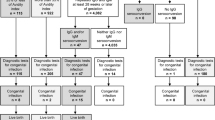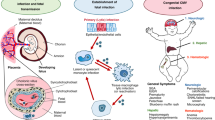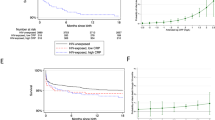Abstract
Epidemiological evidence suggests that childhood acute lymphoblastic leukaemia (ALL) may be initiated by an in infection in utero. Adenovirus DNA was detected in 13 of 49 neonatal blood spots from ALL patients but only in 3 of 47 controls (P=0.012) suggesting a correlation between prenatal adenovirus infection and the development of ALL
Similar content being viewed by others
Main
Acute lymphoblastic leukaemia (ALL) is the most common malignancy in children (Greenlee et al, 2000). Recent studies have shed light on the natural history of this disease. Identification of leukaemia-associated translocations in neonatal blood spots (Guthrie cards) of children who will develop leukaemia years later indicates that the initiating event(s) of ALL usually occur before birth (Gale et al, 1997; Wiemels et al, 1999). Epidemiologic studies (Kinlen, 1988; Kinlen and Doll, 2004) suggest that at least one step in the process of ALL development involves an infectious agent (reviewed in Greaves, 2006). The hallmark genetic mutations, notably translocations, of childhood ALL arise when repair of DNA breaks is faulty or inhibited. Infection with some DNA viruses, notably herpesviruses and adenoviruses, interferes with cellular DNA repair mechanisms (Weitzman and Ornelles, 2005; Wilkinson and Weller, 2006) and could lead to these characteristic genetic changes. To determine whether a prenatal virus infection could lead to the development of pre-leukaemic cells containing characteristic translocations, a correlation is sought between detection of viral DNA in Guthrie cards and the eventual development of leukaemia. This approach showed no association between infection with polyoma viruses (Priftakis et al, 2003), herpesviruses (Bogdanovic et al, 2004; Gustafsson et al, 2006), or parvovirus B19 (Isa et al, 2004) and childhood ALL.
The common, endemic species C adenoviruses (serotypes 1, 2, 5, and 6) normally cause respiratory tract infections in young children (Brandt et al, 1969; Avila et al, 1989) and persistent infection of lymphoid tissues (Garnett et al, 2002). We investigated whether adenovirus infections could be correlated with ALL by studying Guthrie cards from children who later developed ALL and healthy controls.
Materials and methods
Guthrie cards
Neonatal capillary blood spots from newborn Swedish infants were used for this study. These blood spots were collected at 3–5 days of age. Four droplets of capillary blood were taken and blotted onto filter paper (Guthrie card). One blood spot contains about 3 × 104 nucleated cells. Guthrie cards were stored at 4°C.
Patients
Guthrie cards were identified from 49 children born between 1977 and 1998, who were diagnosed with ALL between 1980 and 2001 (Table 2). As a control group Guthrie cards from 47 healthy children, matched for birth date and birthplace, were analysed, using the Swedish Medical Birth Register to identify these children. Written informed consent was obtained from all patients, controls and parents. The local ethics committee of the Karolinska Institutet at the Karolinska University Hospital approved the study protocol.
DNA extraction from Guthrie cards
Three uniform discs, 3 mm in diameter, were punched from one of the four blood spots from the stored material and the DNA extracted as previously described with minor modifications (Barbi et al, 1996).
PCR assays
Two different nested PCR assays were used in this study (nucleotides 18 838–19 205 and 20 721–21 572 of the Ad2 sequence (RefSeq AC000007)). Both assays amplified DNA from all species C serotypes, but not from members of other adenovirus species (A, B, D, E, and F). In some cases, samples were also tested with a quantitative real-time PCR assay (Garnett et al, 2002). As a control, PCR with a set of HLA-DQ alpha primers was performed as described (Saiki et al, 1986).
Statistical analysis
Categorical parameters were evaluated using the Fisher exact test and the Cochran–Mantel–Haenszel test. Logistic regression was used to determine if the clinical outcomes were jointly associated with patient characteristics and adenovirus DNA.
Results
DNA extracted from Guthrie cards from 49 ALL patients and from 47 normal controls was analysed for the presence of species C adenovirus DNA. Individual samples were assayed on at least three separate occasions using two different PCR assays. Thirteen of the ALL samples and three of the control samples contained amplifiable adenovirus DNA (Table 1). These results show a significant association (P=0.012) between species C adenovirus DNA and leukaemia. The odds ratio shows a 5.2-fold (95% CI:1.3–31) greater likelihood of detecting species C adenovirus DNA in the neonatal blood of a child that subsequently develops ALL than in the neonatal blood of a child that does not develop ALL.
Adenovirus DNA levels in positive patient samples were quantified by real-time PCR, which is slightly less sensitive than the nested assays. Five of the 13 ALL samples and none of the three adenovirus DNA-positive control samples contained detectable DNA by real-time PCR (data not shown). The range of DNA copies in these assays was from 1 to 30 with a median of 2.3 copies.
Contingency tables and logistic regression were used to determine if the detection of adenovirus DNA was associated with any patient characteristics or clinical outcomes summarised in Table 2. A non-random (P=0.032) distribution of adenovirus DNA among risk groups was observed. However, the very limited number of adenovirus-positive samples analysed here requires further investigation to determine if this distribution is indeed non-random and if the exclusion of adenovirus DNA from the Guthrie cards of patients in the intermediate-risk group is significant. No other relationship (P>0.5) was found between adenovirus DNA in the neonatal blood spot and the remaining characteristics identified in Table 2.
Discussion
For species C adenovirus to contribute to the earliest steps in development of childhood leukaemia, this virus must infect the fetus at least as frequently as the incidence of neonatal pre-leukaemic clones in the population, estimated at 1–5% (Mori et al, 2002). In addition to being a likely fetal pathogen (Towbin et al, 1994; Van den Veyver et al, 1998; Oyer et al, 2000; Baschat et al, 2003; Reddy et al, 2005), adenovirus DNA is also detected in the amniotic fluid from apparently normal pregnancies. Of 1187 unique samples in four large studies, 64 (5.4%) contained adenoviral DNA (Van den Veyver et al, 1998; Wenstrom et al, 1998; Baschat et al, 2003; Reddy et al, 2005), which compares favourably with 6% adenovirus DNA-positive samples among the normal controls in the present study (Table 1). And, as is the case with children infected post-natally, adenoviral DNA is retained in latently infected T lymphocytes for years following primary infection (Garnett et al, 2002). Thus, the finding of species C adenovirus in neonatal blood spots is evidence of prenatal infection, as is the case for other prenatal viral infections (Barbi et al, 1996; Johansson et al, 1997; Fischler et al, 1999).
Adenovirus DNA sequences have not been detected in cell lines derived from childhood ALL (LR Gooding, unpublished), and, indeed, MacKenzie et al (2006) recently reported that no potential ‘exogenous’ DNA could be detected in leukaemia cells by representational difference analysis, indicating that no DNA virus was present in the cells. Gene products of adenovirus can transform cells in culture by a hit-and-run mechanism that leaves no viral DNA in the transformed cells (Nevels et al, 2001). Because species C adenoviruses profoundly block double-stranded DNA-break repair (Weitzman and Ornelles, 2005), it is conceivable that infection with species C adenovirus could lead to the acquisition of genomic mutations common to childhood ALL.
The finding of a significantly elevated frequency of species C adenovirus DNA in Guthrie cards of children who later developed ALL suggests a potential role for adenovirus at an early stage in the development of this disease. Further research is necessary to determine if this species has a causative role in this disease.
Change history
16 November 2011
This paper was modified 12 months after initial publication to switch to Creative Commons licence terms, as noted at publication
References
Avila MM, Carballal G, Rovaletti H, Ebekian B, Cusminsky M, Weissenbacher M (1989) Viral etiology in acute lower respiratory infections in children from a closed community. Am Rev Respir Dis 140: 634–637
Barbi M, Binda S, Primache V, Luraschi C, Corbetta C (1996) Diagnosis of congenital cytomegalovirus infection by detection of viral DNA in dried blood spots. Clin Diagn Virol 6: 27–32
Baschat AA, Towbin J, Bowles NE, Harman CR, Weiner CP (2003) Prevalence of viral DNA in amniotic fluid of low-risk pregnancies in the second trimester. J Matern Fetal Neonatal Med 13: 381–384
Bogdanovic G, Jernberg AG, Priftakis P, Grillner L, Gustafsson B (2004) Human herpes virus 6 or Epstein–Barr virus were not detected in Guthrie cards from children who later developed leukaemia. Br J Cancer 91: 913–915
Brandt C, Kim H, Vargosko A, Jeffries B, Arrobio J, Rindge B, Parrott R, Chanock R (1969) Infections in 18 000 infants and children in a controlled study of respiratory tract disease. I. Adenovirus pathogenicity in relation to serologic type and illness syndrome. Am J Epidemiol 90: 484–500
Fischler B, Rodensjo P, Nemeth A, Forsgren M, Lewensohn-Fuchs I (1999) Cytomegalovirus DNA detection on Guthrie cards in patients with neonatal cholestasis. Arch Dis Child Fetal Neonatal Ed 80: F130–F134
Gale KB, Ford AM, Repp R, Borkhardt A, Keller C, Eden OB, Greaves MF (1997) Backtracking leukemia to birth: identification of clonotypic gene fusion sequences in neonatal blood spots. Proc Natl Acad Sci USA 94: 13950–13954
Garnett CT, Erdman D, Xu W, Gooding LR (2002) Prevalence and quantitation of species C adenovirus DNA in human mucosal lymphocytes. J Virol 76: 10608–10616
Greaves M (2006) Infection, immune responses and the aetiology of childhood leukaemia. Nat Rev Cancer 6: 193–203
Greenlee RT, Murray T, Bolden S, Wingo PA (2000) Cancer statistics, 2000. CA Cancer J Clin 50: 7–33
Gustafsson B, Jernberg AG, Priftakis P, Bogdanovic G (2006) No CMV DNA in Guthrie cards from children who later developed ALL. Pediatr Hematol Oncol 23: 199–205
Isa A, Priftakis P, Broliden K, Gustafsson B (2004) Human parvovirus B19 DNA is not detected in Guthrie cards from children who have developed acute lymphoblastic leukemia. Pediatr Blood Cancer 42: 357–360
Johansson PJ, Jonsson M, Ahlfors K, Ivarsson SA, Svanberg L, Guthenberg C (1997) Retrospective diagnostics of congenital cytomegalovirus infection performed by polymerase chain reaction in blood stored on filter paper. Scand J Infect Dis 29: 465–468
Kinlen L (1988) Evidence for an infective cause of childhood leukaemia: comparison of a Scottish new town with nuclear reprocessing sites in Britain. Lancet 2: 1323–1327
Kinlen L, Doll R (2004) Population mixing and childhood leukaemia: fallon and other US clusters. Br J Cancer 91: 1–3
MacKenzie J, Greaves MF, Eden TO, Clayton RA, Perry J, Wilson KS, Jarrett R.F (2006) The putative role of transforming viruses in childhood acute lymphoblastic leukemia. Haematologica 91: 240–243
Mori H, Colman SM, Xiao Z, Ford AM, Healy LE, Donaldson C, Hows JM, Navarrete C, Greaves M (2002) Chromosome translocations and covert leukemic clones are generated during normal fetal development. Proc Natl Acad Sci USA 99: 8242–8247
Nevels M, Tauber B, Spruss T, Wolf H, Dobner T (2001) ‘Hit-and-run’ transformation by adenovirus oncogenes. J Virol 75: 3089–3094
Oyer CE, Ongcapin EH, Ni J, Bowles NE, Towbin JA (2000) Fatal intrauterine adenoviral endomyocarditis with aortic and pulmonary valve stenosis: diagnosis by polymerase chain reaction. Hum Pathol 31: 1433–1435
Priftakis P, Dalianis T, Carstensen J, Samuelsson U, Lewensohn-Fuchs I, Bogdanovic G, Winiarski J, Gustafsson B (2003) Human polyomavirus DNA is not detected in Guthrie cards (dried blood spots) from children who developed acute lymphoblastic leukemia. Med Pediatr Oncol 40: 219–223
Reddy UM, Baschat AA, Zlatnik MG, Towbin JA, Harman CR, Weiner CP (2005) Detection of viral deoxyribonucleic acid in amniotic fluid: association with fetal malformation and pregnancy abnormalities. Fetal Diagn Ther 20: 203–207
Saiki RK, Bugawan TL, Horn GT, Mullis KB, Erlich HA (1986) Analysis of enzymatically amplified beta-globin and HLA-DQ alpha DNA with allele-specific oligonucleotide probes. Nature 324: 163–166
Towbin JA, Griffin LD, Martin AB, Nelson S, Siu B, Ayres NA, Demmler G, Moise KJ, Zhang YH (1994) Intrauterine adenoviral myocarditis presenting as nonimmune hydrops fetalis: diagnosis by polymerase chain reaction. Pediatr Infect Dis J 13: 144–150
Van den Veyver IB, Ni J, Bowles N, Carpenter Jr RJ, Weiner CP, Yankowitz J, Moise Jr KJ, Henderson J, Towbin JA (1998) Detection of intrauterine viral infection using the polymerase chain reaction. Mol Genet Metab 63: 85–95
Weitzman MD, Ornelles DA (2005) Inactivating intracellular antiviral responses during adenovirus infection. Oncogene 24: 7686–7696
Wenstrom KD, Andrews WW, Bowles NE, Towbin JA, Hauth JC, Goldenberg RL (1998) Intrauterine viral infection at the time of second trimester genetic amniocentesis. Obstet Gynecol 92: 420–424
Wiemels JL, Cazzaniga G, Daniotti M, Eden OB, Addison GM, Masera G, Saha V, Biondi A, Greaves MF (1999) Prenatal origin of acute lymphoblastic leukaemia in children. Lancet 354: 1499–1503
Wilkinson DE, Weller SK (2006) Herpes simplex virus type I disrupts the ATR-dependent DNA-damage response during lytic infection. J Cell Sci 119: 2695–2703
Acknowledgements
We thank Ulrika von Döbeln, chief of the ‘PKU-Laboratoriet’, for providing Guthrie cards, Britta Lindqvist for excellent work organising the neonatal samples, and Sandberg Marie and Nina Timelin for helping organise medical journals. We also thank Dr Erik Forestier for helping us with cytogenetic data. This work was supported by grants from The Swedish Child Cancer Foundation to BG, the National Cancer Institute to DAO (CA77342), and the National Institute of Allergy and Infectious Disease to LRG (AI52280).
Author information
Authors and Affiliations
Corresponding author
Rights and permissions
From twelve months after its original publication, this work is licensed under the Creative Commons Attribution-NonCommercial-Share Alike 3.0 Unported License. To view a copy of this license, visit http://creativecommons.org/licenses/by-nc-sa/3.0/
About this article
Cite this article
Gustafsson, B., Huang, W., Bogdanovic, G. et al. Adenovirus DNA is detected at increased frequency in Guthrie cards from children who develop acute lymphoblastic leukaemia. Br J Cancer 97, 992–994 (2007). https://doi.org/10.1038/sj.bjc.6603983
Received:
Revised:
Accepted:
Published:
Issue Date:
DOI: https://doi.org/10.1038/sj.bjc.6603983
Keywords
This article is cited by
-
Whole genomic analysis of two potential recombinant strains within Human mastadenovirus species C previously found in Beijing, China
Scientific Reports (2017)
-
Virome characterisation from Guthrie cards in children who later developed acute lymphoblastic leukaemia
British Journal of Cancer (2016)
-
Adenovirus DNA in Guthrie cards from children who develop acute lymphoblastic leukaemia (ALL)
British Journal of Cancer (2010)
-
Seroprevalence of Human Herpes Simplex, Hepatitis B and Epstein-Barr Viruses in Children with Acute Lymphoblastic Leukemia in Southern Iran
Pathology & Oncology Research (2010)
-
Adenovirus detection in Guthrie cards from paediatric leukaemia cases and controls
British Journal of Cancer (2008)



